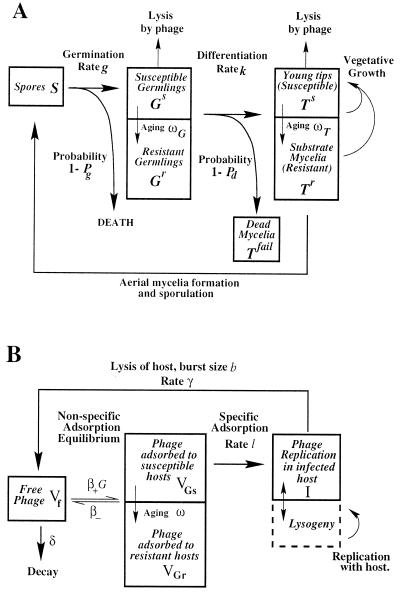FIG. 1.
(A) Schematic representation of the host dynamics. Germlings and young tips are initially susceptible to phage lysis (compartments Gs and Ts) but acquire resistance as they age at rates ωG and ωT, respectively (resistant compartments Gr and Tr). After germination, germlings differentiate into exponentially growing substrate mycelium at rate k. Germlings are viable with probability Pg and are successful in forming colonies with probability Pd. If either probability is <1, then a drop in total propagules occurs after germination, which can alternatively be described as death rates g(1 − Pg) and k(1 − Pd) of spores and germlings, respectively. Germlings that die still adsorb phage nonspecifically (Tfail). In the basic model Pg is 1 and ωT is large so that young tips are effectively resistant. (B) Schematic representation of the phage dynamics interacting with germlings. Interaction with substrate is similar, with T replacing G. Phage adsorbs to mycelia in a two-step process: nonspecific reversible adsorption (forward rate β+ × mycelium density G, reverse rate β−) producing phage VGs and VGr adsorbed to susceptible and resistant germlings, respectively, and specific adsorption leading to host lysis, which is modeled as an infection event (rate l) after nonspecific adsorption. This produces a replicating phage state in an infected host I. Lysis occurs at a rate γ, releasing b free-phage particles. In a model extension, lysogeny is also included as an outcome of infection. Host aging and differentiation transfer adsorbed phage between compartments following host changes. Thus, resistance can be acquired before infection by nonspecific adsorbed phage.

